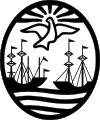List of mayors and chiefs of government of Buenos Aires City facts for kids
Quick facts for kids Chief of Government of Buenos Aires |
|
|---|---|

Coat of arms of Buenos Aires
|
|
| Style | No courtesy, title or style |
| Residence | Buenos Aires City Hall |
| Appointer | Citizens of Buenos Aires |
| Term length | 4 years (renewable) |
| Inaugural holder | Torcuato de Alvear (mayor) Fernando de la Rúa (chief) |
| Formation | 10 May 1883 (mayor) 6 August 1996 (chief) |
This article is about the leaders of Buenos Aires, the capital city of Argentina. These leaders have been called either mayors or chiefs of government. We will look at how this important role has changed since Buenos Aires became the country's capital.
For a long time, Buenos Aires did not have much power over its own decisions. The person in charge, called the Intendant (or Mayor), was chosen directly by the President of Argentina. This meant the city had less freedom than even smaller towns. The very first Mayor was Torcuato de Alvear, who started his job in 1883. He was chosen by President Julio Argentino Roca.
Things changed a lot in 1994. Argentina updated its main law, the Constitution. This change gave Buenos Aires special "autonomous" status. This means the city gained more control over its own affairs, like a province. Because of this, the leader's title changed from Mayor to Chief of Government (Jefe de Gobierno). Now, the people of Buenos Aires get to vote directly for their Chief of Government. There is also a Vice-Chief of Government, who is elected at the same time. Even though the official title is Chief of Government, many people, especially outside Argentina, still call them the Mayor.
The Chief and Vice-Chief of Government are elected together for a four-year term. They can also be re-elected. The first person elected directly as Chief of Government was Fernando de la Rúa. He later became the President of Argentina. In 2006, Chief Aníbal Ibarra was removed from his job after a serious event related to a nightclub fire. His Vice-Chief, Jorge Telerman, then took over the position. Later, Mauricio Macri was elected Chief of Government in 2007. After him, Horacio Rodríguez Larreta became Chief in 2015.
Chiefs of Government (1996–Present)
Since Buenos Aires became an autonomous city, its leaders have been chosen by the people. Here are the Chiefs of Government who have led the city since 1996:
| # | Portrait | Name (Born–Died) |
Time in Office | Political Party (Group) |
Deputy Chief (s) | |||
|---|---|---|---|---|---|---|---|---|
| 1 |  |
Fernando de la Rúa (1937–2019) |
August 6, 1996 | December 10, 1999 | Radical Civic Union (Alliance) |
Enrique Olivera | ||
| 2 |  |
Enrique Olivera (1940–2014) |
December 10, 1999 | August 5, 2000 | Radical Civic Union (Alliance) |
vacant | ||
| 3 |  |
Aníbal Ibarra (born 1958) |
August 6, 2000 | March 7, 2006 | Broad Front (Frepaso) |
Cecilia Felgueras | ||
| Jorge Telerman | ||||||||
| 4 |  |
Jorge Telerman (born 1956) |
March 7, 2006 | December 10, 2007 | Justicialist Party (Frepaso) |
vacant | ||
| 5 |  |
Mauricio Macri (born 1959) |
December 10, 2007 | December 10, 2015 | Republican Proposal (Cambiemos) |
Gabriela Michetti | ||
| María Eugenia Vidal | ||||||||
| 6 |  |
Horacio Rodríguez Larreta (born 1965) |
December 10, 2015 | December 10, 2023 | Republican Proposal (Juntos por el Cambio) |
Diego Santilli (until July 21, 2021) |
||
| 7 |  |
Jorge Macri (born 1965) |
December 10, 2023 | Incumbent | Republican Proposal (Juntos por el Cambio) |
Clara Muzzio | ||
See also
- Politics of Argentina
- Autonomous City of Buenos Aires
- Federalization of Buenos Aires


